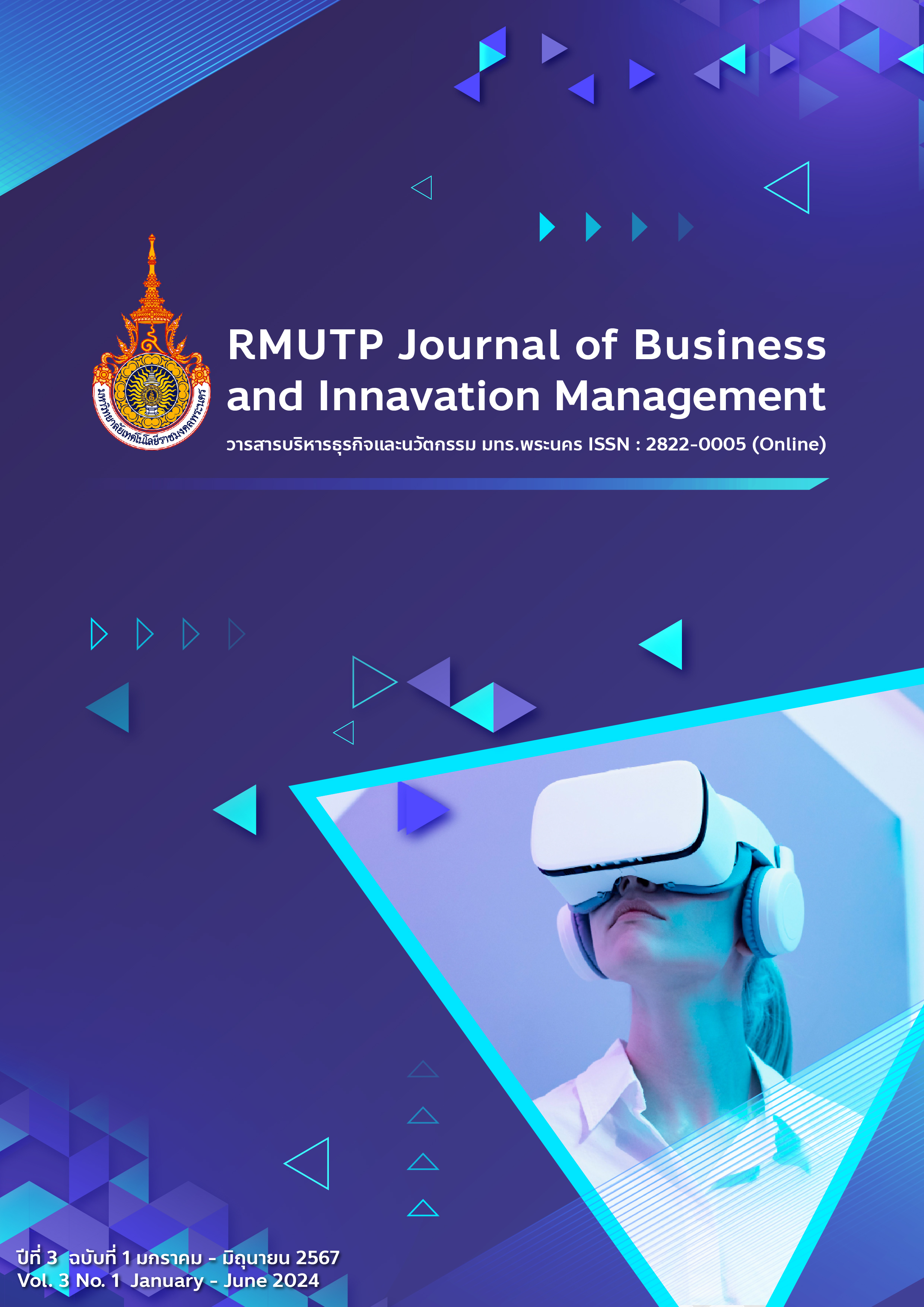A Study of Consumer Behavior and Marketing Mix that Influences the Decision to Buy a Savings Lottery Ticket of Government Housing Bank, Sukhothai Branch.
Main Article Content
Abstract
This research aims to: 1) compare the demographic factors that affect the decision to buy lottery tickets from the Sukhothai branch of the Government Housing Bank, 2) compare the factors related to consumer behavior that influence the decision to purchase lottery tickets from the Sukhothai branch of the Government Housing Bank, and 3) study the marketing mix that has an impact on the decision to buy lottery tickets from the Sukhothai branch of the Government Housing Bank. The research analyzed data from 400 customers who purchased Government Housing Bank savings lottery tickets at the Sukhothai branch. Frequency, percentage, average, and standard deviation were used in statistical analysis. T-test, One-way ANOVA, and multiple regression analysis were used to test the research hypothesis. The study found that gender, age, occupation, income, and education significantly influenced the decision to purchase Government Housing Bank tickets at a .05 level of significance. The study analyzed the factors that influence consumer behavior when purchasing tickets from the Government Housing Bank, Sukhothai Branch. These factors include the purpose, budget, frequency, and holding period of the tickets. The study also found that these factors had a significant impact on the decision to buy tickets, based on the analysis of the lottery ticket sales data. Government Housing Bank lotteries, Sukhothai branch, along with market mix factors influence buying decisions with 70.6 percent statistical significance at 0.05
Article Details

This work is licensed under a Creative Commons Attribution-NonCommercial-NoDerivatives 4.0 International License.
Articles published in the Journal of Business Administration and Innovation Rajamangala University of Technology Phra Nakhon contains information and content. The article's single author is accountable for it. In all instances, the journal's editors are not accountable for any losses incurred.
References
กุสุมา ภูมิลำเนา. (2565). ปัจจัยที่มีผลต่อการตัดสินใจซื้อสลากออมทรัพย์ ธอส. ของลูกค้าธนาคารอาคารสงเคราะห์ ในเขตกรุงเทพมหานครและปริมณฑล. การศึกษาค้นคว้าอิสระบริหารธุรกิจมหาบัณฑิต สาขาบริหารธุรกิจ มหาวิทยาลัยรามคำแหง.
กัลยา วานิชย์บัญชา. (2559). การวิเคราะห์สถิติ : สถิติสำหรับบริหารและวิจัย (พิมพ์ครั้งที่16) กรุงเทพฯ: โรงพิมพ์จุฬาลงกรณ์มหาวิทยาลัย.
ญานิกา ศรีทอง. (2563). ปัจจัยที่มีผลต่อการออมในรูปแบบของสลากออมทรัพย์ ธอส. ของประชากรในเขตกรุงเทพมหานคร. การศึกษาค้นคว้าอิสระบริหารธุรกิจมหาบัณฑิต สาขาบริหารธุรกิจ มหาวิทยาลัยรามคำแหง.
ธนพล คันธชาติศิริกุล. (2562). ปัจจัยที่มีผลต่อการตัดสินใจซื้อสลากออมสินพิเศษที่ธนาคารออมสิน สาขาสาธรซิตี้ ทาวเวอร์. การศึกษาค้นคว้าอิสระ ปริญญาบริหารธุรกิจมหาบัณฑิต มหาวิทยาลัยสยาม.
ธนาคารแห่งประเทศไทย. (2563). การวางแผนการเงิน [ออนไลน์]. เข้าถึงจาก: https://www.bot.or.th/th/satang-story/money-plan/planning-steps.html
ธนาคารอาคารสงเคราะห์. (2565). สลากออมทรัพย์ คืออะไร? ผลตอบแทนประมาณเท่าไหร่? เหมาะกับใคร? [ออนไลน์]. เข้าถึงจาก: https://blog.ghbank.co.th/what-is-saving-lottery/
ธนาคารอาคารสงเคราะห์ ภาคเหนือตอนล่าง. (2565). รายงานสรุปยอดสินชื่อปล่อยใหม่ และเงินฝาก สลากส่วนเพิ่มภาคเหนือตอนล่าง ณ วันที่ 29 ธันวาคม 2565. เข้าถึงจาก https://webmail.ghb.co.th/#2
บุญชม ศรีสะอาด. (2556). วิธีการทางสถิติสำหรับการวิจัย เล่ม 1. (พิมพ์ครั้งที่ 5). กรุงเทพฯ: สุวีริยาสาส์น.
พัชรา หร่าแขก, กมลรัตน์ พูลสระคู, ธิติสุดา มุสิกาวงษ์, ธีรวัฒน์ ช้างสุวัฒน์ และมนัสวี โมลานิล. (2564). ปัจจัยที่มีความสัมพันธ์กับการตัดสินใจซื้อสลากออมสินที่ธนาคารออมสินสาขากรีนพลาซ่าวังหิน. การค้นคว้าอิสระ การเงินการธนาคารบัณฑิต คณะวิทยาการจัดการ มหาวิทยาลัยราชภัฏจันทรเกษม.
สุกานดา พฤกษติกุล. (2565). ปัจจัยที่มีผลต่อการตัดสินใจซื้อสลากออมสินพิเศษดิจิทัลของพนักงานธนาคารออมสิน สำนักงานใหญ่. บทความ สาขาวิชาการจัดการ คณะบริหารธุรกิจ มหาวิทยาลัยรามคำแหง.
สุทิน ชนะบุญ. (2566). สถิติและการวิเคราะห์ข้อมูลในงานวิจัยเบื้องต้น. เข้าถึงได้จาก: http://kkpho.go.th/km/index.php/2017-08-10-06-37-01/category/2-r2r-5. (วันที่ค้นข้อมูล : 9 กันยายน 2566).
เสรี วงษ์มณฑา. (2542). กลยุทธ์การตลาด การวางแผนการตลาด. กรุงเทพมหานคร: ธีระฟิลม์และไซเท็กซ์.
ศิริวรรณ เสรีรัตน์, ศุภร เสรีย์รัตน์, องอาจ ปทะวานิช และปริญ ลักษิตานนท์. (2546). การบริหารการตลาดยุคใหม่. กรุงเทพฯ: บริษัท ธีระฟิล์ม และไซเท็กซ์ จำกัด.
อภิทริน วงษ์อัยรา, สมบูรณ์ ศรีนุรักษ์วงศ์ และประภัสสร วิเศษประภา. (2562). ความคาดหวังองค์ประกอบของผลิตภัณฑ์และคุณค่าตราสินค้าที่มีอิทธิพลต่อการตัดสินใจซื้อสลากออมทรัพย์ ธอส.ของประชาชนในเขตกรุงเทพมหานคร. การศึกษาค้นคว้าอิสระบริหารธุรกิจมหาบัณฑิต มหาวิทยาลัยรามคำแหง.
Belch, George E. & Belch, Michael A. (1993). Introduction to Advertising and Promotion. 2nd ed. Boston : Richard D Irwin.
Kotler, P. (1997). Marketing Management: Analysis, Planning, Implementation and Control (14th Global ed.). Upper Saddle River, NJ: Prentice-Hall.
Kotler, P. (2000). Marketing management: Analyzing consumer marketing and Buyer behavior (The Millennium). New Jersey: Prentice Hall.
Kotler, P. (2012). Marketing Management (12th ed.). Prentice-Hall.
Kuester & Sabine. (2012). MKT 301: Strategic Marketing & Marketing in Specific Industry.Contexts,University of Mannheim, 110.
Likert, R. (1981). Management Styles and The Human Component in Leadership on the Job: Guides to Good Supervision. New York: AMACOM.
Magrath, A.J. (1986). When Marketing Services, 4Ps are not enough.Business Horizons,29, 44-50
Taro Yamane. (1973). Statistics: An Introductory Analysis. New York: Harper and Row.


